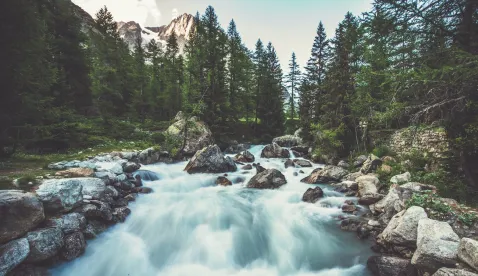On April 21, 2020, the United States Environmental Protection Agency (U.S. EPA) and the United States Army Corps of Engineers (USACE) published in the Federal Register the so-called “Step Two” rule revising the definition of the term, “Waters of the United States” now entitled the “Navigable Waters Protection Rule” (Step Two Rule). The Step Two Rule, if upheld by the federal courts, will narrow the universe of wetlands and waterways subject to jurisdiction under Section 10 of the Rivers and Harbors Act of 1899 and Sections 401 and 404 of the Clean Water Act (CWA). While potentially streamlining the permitting process by requiring a connection to a navigable waterway before federal wetland jurisdiction is triggered, the rules face almost certain challenge in the federal courts and are likely to be stayed in a significant minority, or a potential majority, of the states while that litigation progresses. For that reason, for the foreseeable future permittees should confirm the specific wetland regulations applicable to their state as a part of project design (of which there currently are three: the Navigable Waters Rule, the 2015 Waters of the United States Rule, and the pre-2015 USACE rules).
As discussed in prior alerts, the Clean Water Rule is the latest attempt to clarify the scope of federal jurisdiction over wetlands and waterways in light of two decisions of the U.S. Supreme Court. The Court has provided only limited guidance as to the universe of wetland and waterways subject to federal jurisdiction under the term “waters of the United States” in Solid Waste Agency of Northern Cook County v. United States Army Corps of Engineers, 531 U.S. 159 (2001) ("SWANCC") and Rapanos v. United States, 547 U.S. 715 (2006) (Rapanos). In Rapanos, the majority of justices did not agree on the test for jurisdictional waters. While Justice Kennedy took the position that jurisdiction was triggered by a “significant nexus” to a traditionally navigable water, Justice Scalia issued an opinion advancing a narrower test requiring a connection to a traditionally navigable water. In the ensuing decade, U.S. EPA and USACE implemented the “significant nexus” test through guidance documents and used it as the basis for the 2015 Waters of the United States Rule which broadly asserted jurisdiction over traditional waters as well as areas within the 100-year floodplain of certain waters or within 4,000 feet of the high water or high tide line or the ordinary high water mark of a traditional navigable water. That rule was challenged almost immediately in the federal courts.
In Executive Order 13778, President Trump directed EPA and USACE to consider rescinding or revising the 2015 Waters of the United States Rule and to conduct a future rulemaking implementing the test set forth in Justice Scalia’s opinion in Rapanos.1 U.S. EPA and USACE implemented that Executive Order through two rules: the Step One rule, issued on October 22, 2019, repealed the 2015 Waters of the United States Rule and re-codified the pre-2015 USACE regulations. The Step Two rule, published on April 21, implements Justice Scalia’s narrower opinion tying federal jurisdiction to a direct connection to a traditional navigable waterway.
Under the Step Two Rule, four categories of waters are considered “waters of the United States”:
-
Territorial seas and traditional navigable waters;
-
Tributaries of jurisdictional waters;
-
Lakes, ponds, and impoundments that contribute surface water flow to a jurisdictional water in a typical year; and
-
Wetlands adjacent to non-wetland jurisdictional waters.
Under the rule, a wetland is considered “adjacent” if it:
-
Abuts (i.e., touches a side or corner of) another non-wetland jurisdictional water;
-
Is inundated by flooding from another non-wetland jurisdictional water at least once in a typical year;
-
Is physically separated from a non-wetland jurisdictional water by a natural berm, bank, dune, or similar natural feature without regard to whether there is a specific hydrological surface connection in a typical year; or
-
Is physically separated from a non-wetland jurisdictional water by an artificial structure like a road, dike, or barrier as long as the structure allows for a direct hydrologic surface connection between the wetland and the other jurisdictional water at least once in a typical year. This connection can be through a gate or culvert or even by water overtopping a road.
The Step Two Rule also identifies waters specifically excluded from that definition. These include: any category of water not explicitly regulated; groundwater and groundwater recharge facilities; ephemeral streams; diffuse storm water runoff; artificially irrigated areas, and artificial lakes and ponds that do not impound otherwise jurisdictional waters, among other categories specified in the Rule. The twelve categories of non-jurisdictional waters in the Step Two Rule include:
-
All waters not covered by the four categories of WOTUS discussed above;
-
Groundwater;
-
Ephemeral features;
-
Storm water runoff and overland sheet flow;
-
All ditches not considered “tributaries;”
-
Prior converted cropland;
-
Artificially irrigated areas;
-
Certain artificial lakes and ponds;
-
Water-filled depressions or pits excavated in connection with mining or construction or to obtain fill, sand, or gravel;
-
Certain storm water control features;
-
Groundwater recharge, water reuse, and wastewater recycling structures; and
-
Wastewater treatment systems.
While the effective date of the Phase Two Rule is June 22, 2020, it is likely to be challenged in multiple courts across the country by a coalition of states and public interest groups. Similar challenges to the 2015 Waters of the United States Rule resulted in injunctions applying to only a limited number of states with the somewhat incongruous result that federal jurisdiction differed on a state-by-state basis.
In light of this uncertainty, project developers and mitigation bank owners should consider evaluating both project impacts and mitigation strategies under all three potentially-applicable rules. In states not challenging the Step Two Rule, it is likely to enter into effect and projects may seek jurisdictional determinations from USACE applying that rule, especially if federal jurisdiction hinged on isolated wetlands not directly connected to a traditional navigable water. Mitigation banks located in those states will need to evaluate whether their banks still satisfy the pre-requisites for federal jurisdiction and whether the USACE will still recognize credits generated by those banks as acceptable mitigation if the bank itself is no longer located in a water of the United States regulated by the USACE. For projects and wetlands located in states where the new rule will likely not apply due to challenge, project developers and banks may need to consider all three rulemakings to confirm that project permitting strategies can address any change in the scope of USACE jurisdiction over potentially-impacted wetlands and any wetland banks relied upon for mitigation.




 />i
/>i


